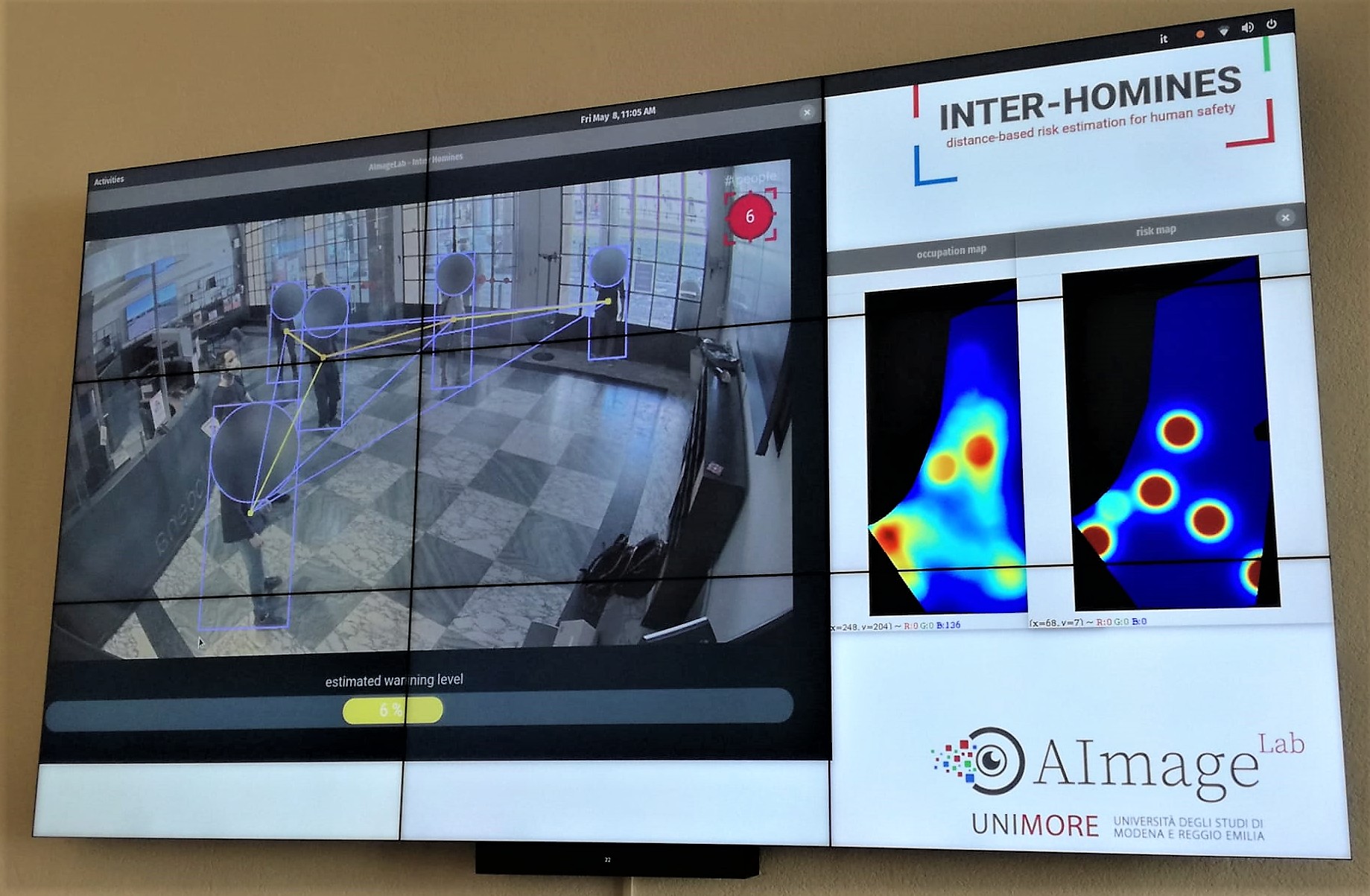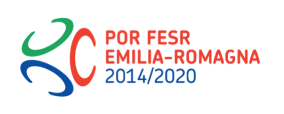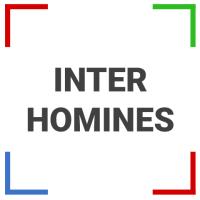

Inter-Homines - Distance-based risk estimation for human safety
Inter-Homines evaluates in real-time the contagion risk of a monitored area by analyzing video streams: it is able to locate people in 3D space, recognize Personal Protective Equipment, calculate interpersonal distances and predict risk levels by building dynamic maps of the monitored area. Inter-Homines works both indoor and outdoor, in public and private variable crowded areas. The software is applicable to already installed cameras or low-cost cameras on industrial PCs, equipped with an additional embedded edge-AI system for temporary measurements.
The video processing complies with the privacy regulations by not recording visual data, and respects the European guidelines on AI in terms of transparency, trustworthy and explicability. Inter-Homines defines a model, validated by epidemiologists and parameterizable according to current regulations, which allows in real-time to associate to each monitored area: a) a space-time risk index, b) a dynamic safety level of the area, c) a dynamic map of interpersonal distances and d) a dynamic map of where and how many people can be added to remain safe.
We propose a solution for modeling the risk of possible contagiousity in a given area monitored by RGB cameras where people freely move and interact. From the AI-side, we exploit a robust pipeline for real-time people detection and localization in the ground plane by homographic transformation based on state-of-the-art computer vision algorithms; it is a combination of people detector and pose estimator in the image space as well as a multi-person people detection in 3D. From the risk modeling side, we propose a parametric model for a spatio-temporal dynamic risk estimation, that validated by epidemiologists could be useful for safety monitoring and risk level prediction in indoor and outdoor scenes.

The COVID-19 emergency has changed the way we live interpersonal sociality, at work, in public and private spaces, in places of education culture and leisure. Democracy of the risk of contagion seems full-blown; until now, there are no studies that correlate geographical areas, places open or closed with the greatest spread of the virus: instead everything seems to correlate the contagion to proximity or to the contact between infected people and people susceptible to infection.
The spread of the infection seems to follow the epidemiological models that derive from the SIR models. The "phase 2" that Italy is going to undertake will be characterized by living with the risk of contagion: the prerogative will be to take conscious and possibly interactive measures to minimize the possibility of contagion, while seeking a necessary resumption of social and working life.
Certainly the technologies IT and in particular of Artificial Intelligence will be a formidable aid to define and predict risk levels in potentially crowded places, the verification of safety levels. Inter-Homines provides an innovative and effective technological contribution based on Artificial Intelligence, through services and systems for the dynamic monitoring of distance-related prevention measures interpersonal with or without IPR and the real-time calculation of the level of risk, with particular reference to workplaces, public places and socialites.
The first objective is to provide a reliable tool, in accordance with privacy and usage guidelines of the AI, to calculate in real-time the actual compliance with the prevention measures for "spacing", also interactively reporting any risk situations. The second is to provide an innovative model for the dynamic calculation of the risk of the monitored site that can be used as a tool for prevention, control, monitoring, and planning, support to the population and workers in order to implement conscious attendance, linked to effective compliance with the measures in force.

Installations Currently Acrive
Our system is currently active at the following locations:
What they say about us:
Active Collaborations
We are working with:
UNIMORE has approved the creation of the new Go@AI start-up for the final industrialization and the next Inter-Homines phases.
Acknowledgments
The work is supported by Regione Emilia Romagna under the project Inter-Homines among the 16 research and innovation projects for the development of solutions aimed at contrasting the epidemic of COVID19.

The project was co-financed by the FSC (Fondo per lo Sviluppo e la Coesione).

Research
Additional details can be found in our scientific work:
Our work has its foundations on multiple research activites and many years of experience in the Computer Vision field:
- Compressed Volumetric Heatmaps for Multi-Person 3D Pose Estimation, CVPR 2020
- Learning to Detect and Track Visible and Occluded Body Joints in a Virtual World, ECCV 2018
- Performance Measures and a Data Set for Multi-Target, Multi-Camera Tracking, ECCV 2016
- Socially Constrained Structural Learning for Groups Detection in Crowd, PAMI 2015
Publications
| 1 |
Fabbri, Matteo; Lanzi, Fabio; Calderara, Simone; Alletto, Stefano; Cucchiara, Rita
"Compressed Volumetric Heatmaps for Multi-Person 3D Pose Estimation"
Proceedings of the IEEE/CVF Conference on Computer Vision and Pattern Recognition,
Seattle,
pp. 7202
-7211
,
June, 16-18 2020,
2020
| DOI: 10.1109/CVPR42600.2020.00723
Conference

|
| 2 |
Fabbri, Matteo; Lanzi, Fabio; Calderara, Simone; Palazzi, Andrea; Vezzani, Roberto; Cucchiara, Rita
"Learning to Detect and Track Visible and Occluded Body Joints in a Virtual World"
Proceedings of the 15th European Conference on Computer Vision (ECCV) 2018,
vol. 11208,
Munich (Germany),
pp. 450
-466
,
September, 8-14 2018,
2018
| DOI: 10.1007/978-3-030-01225-0_27
Conference

|
Project Info
